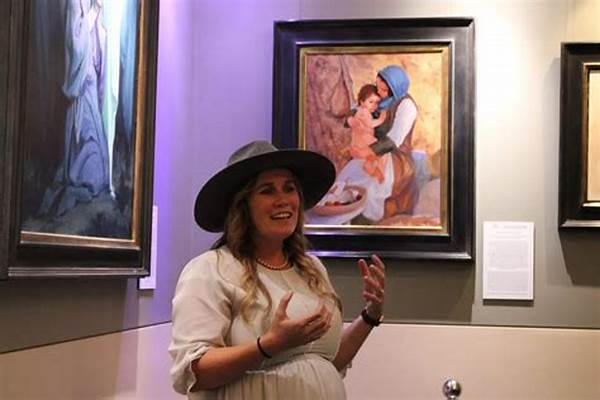
Emotional Storytelling In Artwork
- Daniel Anderson
- 0
- Posted on
Art has always been a powerful medium to convey narratives and evoke emotions. When we talk about emotional storytelling in artwork, we’re diving into a world where brush strokes, color palettes, and textures tell tales as old as time. Artists, from every corner of the globe, harness the emotional power of their craft to connect with audiences on a deeply personal level. This technique transcends traditional storytelling, capturing emotions that resonate universally. So, what’s the scoop on how artists pull it off? Let’s dig in!
Read Now : Evening Music Sessions Cafés
The Power of Art to Convey Emotions
In the vast realm of emotional storytelling in artwork, the magic doesn’t just lie in aesthetics. It’s more about how each piece sparks a connection. Imagine standing in front of a painting and feeling an emotion you can’t quite put your finger on – that’s the magic! Artists weave stories with their tools, painting vivid tales through colors and composition. A burst of red can shout anger or passion, while a soft blue whispers of calm or sadness. Each hue has its role in storytelling, creating symphonies on the canvas without saying a single word. The energy radiating from such art can truly hit home, speaking volumes without uttering a sound. It’s like art has its own slang, a secret language, that anyone, regardless of where they come from, can understand.
Expressing Emotions: Five Slang Styles in Art
1. Vibes: It’s all about the overall feeling that art gives off. Emotional storytelling in artwork can set the vibe for an entire room.
2. Feels: Art isn’t just seen; it’s felt. Emotional storytelling in artwork is packed with feels that grip your heart.
3. Low-key: Subtle hues and gentle strokes that whisper instead of shout. Emotional storytelling in artwork isn’t always loud.
4. Dope: When art stuns you with its brilliance. Emotional storytelling in artwork can be seriously dope!
5. Lit: Art that’s so engaging it’s almost on fire. When emotional storytelling in artwork blazes with intensity.
How Artists Use Slang to Amplify Emotion
In the artistic world, slang isn’t just confined to verbal communication. Emotional storytelling in artwork often uses a visual slang—a unique way to break down complex emotions into digestible visuals. It adds an element of relatability, a ‘cool’ factor that makes the art feel alive and engaging. Much like how we use slang in daily chit-chat to establish camaraderie or infuse humor, artists use visual slang to create an intimate bond with the audience. Think of a vivid graffiti piece or a contemporary pop-art painting—each utilizes color and form to speak an accessible, potent visual slang. This helps artists keep their work relevant and relatable, connecting them to a modern audience while inviting them to perceive art from fresh, unprecedented angles.
Read Now : Best Nutrients To Cure Hangover
Getting to the Heart with Everyday Expressions
There’s a certain beauty in using everyday language to communicate profound emotions, and this is where emotional storytelling in artwork shines through. Artists adopting this approach transform everyday objects and scenes into compelling stories. A crumpled piece of paper or a lone tree on a hilltop can suddenly become a powerful narrative of hope, despair, or resilience. Such art draws heavily from the environment and experiences around us, reflecting everything from mundane moments to pivotal events with an authenticity that’s unmistakably relatable. Emotional storytelling in artwork, when mixed with these familiar expressions, delivers a punch that’s both immediate and lasting, forever changing how we perceive the world around us.
Incorporating Emotions Through Visual Language
Visual language in art is like the lingo of the creative world, allowing artists to speak volumes without uttering a word. Emotional storytelling in artwork turns every brushstroke, shade, and texture into part of a larger dialogue—one that bridges the space between artist and viewer. By using colors, shapes, and lines strategically, artists can convey emotions that sometimes even words fail to express. For instance, abstract art often taps into our subconscious, eliciting feelings that we might not be fully aware of. Artists harness this by understanding how different visual elements can provoke different reactions. It’s like creating an emotional symphony—a composition of visual notes that resonates on a visceral level.
Understanding Art Slang: Beyond Literal Interpretation
Artists often embrace a playful engagement with their medium, akin to using slang in language. Emotional storytelling in artwork thrives on this dynamic, making art an avenue for exploration and discovery. Instead of rigid lines and traditional forms, artists might play with distorted shapes, exaggerated forms, or unconventional materials. This is their version of bending linguistic rules—allowing them to push boundaries and innovate. When viewers engage with such pieces, they are not simply witnessing a static image; they’re embarking on a journey. This journey is guided by an unspoken slang—a visual shorthand—that invites viewers to decipher meanings and feel the weight of emotions beyond the literal depiction.
Summing Up the Visual Slang in Art
In capturing emotional storytelling in artwork, visual slang is at the heart of artistic expression. It’s a tool that artists wield to translate their vision into a universal language of emotion. This use of visual slang encourages viewers to look past the surface and dig deeper into the narrative beneath. Emotional storytelling in artwork through this medium becomes a dance between the tangible and intangible, where emotions flow freely from canvas to the heart. By bypassing conventional storytelling methods, artists invite us to engage with art in an intuitive and personal way, making every encounter with art a unique experience, defined by individual perception and lived experiences.